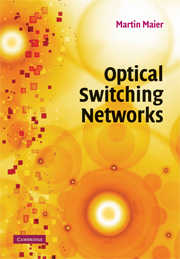Book contents
- Frontmatter
- Contents
- List of illustrations
- List of tables
- Preface
- Acknowledgments
- Part I Introduction
- Part II Optical wide area networks
- Part III Optical metropolitan area networks
- Overview
- 11 Resilient packet ring
- 12 WDM ring networks
- 13 RINGOSTAR
- Part IV Optical access and local area networks
- Part V Testbeds
- Bibliography
- Index
11 - Resilient packet ring
from Part III - Optical metropolitan area networks
Published online by Cambridge University Press: 10 May 2010
- Frontmatter
- Contents
- List of illustrations
- List of tables
- Preface
- Acknowledgments
- Part I Introduction
- Part II Optical wide area networks
- Part III Optical metropolitan area networks
- Overview
- 11 Resilient packet ring
- 12 WDM ring networks
- 13 RINGOSTAR
- Part IV Optical access and local area networks
- Part V Testbeds
- Bibliography
- Index
Summary
The IEEE standard 802.17 Resilient Packet Ring (RPR) aims at combining SONET/SDH's carrier-class functionalities of high availability, reliability, and profitable TDM service (voice) support with Ethernet's high bandwidth utilization, low equipment cost, and simplicity (Davik et al., 2004; Yuan et al., 2004; Spadaro et al., 2004). RPR is a ring-based architecture consisting of two counter directional optical fiber rings with up to 255 nodes. Similar to SONET/SDH, RPR is able to provide fast recovery from a single link or node failure within 50 ms, and carry legacy TDM traffic with a high level of quality of service (QoS). Similar to Ethernet, RPR provides advantages of low equipment cost and simplicity and exhibits an improved bandwidth utilization due to statistical multiplexing. The bandwidth utilization is further increased by means of spatial reuse. In RPR, packets are removed from the ring by the corresponding destination node (destination stripping). The destination stripping enables nodes in different ring segments to transmit simultaneously, resulting in spatial reuse of bandwidth and an increased bandwidth utilization. Furthermore, RPR provides fairness, as opposed to today's Ethernet, and allows the full ring bandwidth to be utilized under normal (failure-free) operation conditions, as opposed to today's SONET/SDH rings where 50% of the available bandwidth is reserved for protection. Current RPR networks are single-channel systems (i.e., each fiber ring carries a single wavelength channel) and are expected to be primarily deployed in metro edge and metro core areas.
In the following sections, we explain RPR in greater detail, paying particular attention to its architecture, access control, fairness control, and protection.
- Type
- Chapter
- Information
- Optical Switching Networks , pp. 161 - 173Publisher: Cambridge University PressPrint publication year: 2008
- 3
- Cited by



